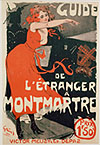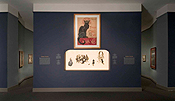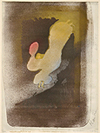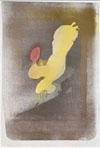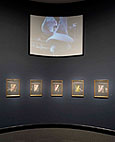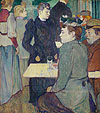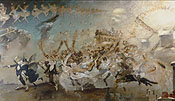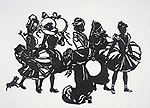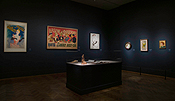X
Please wait for the PDF.
The browser will either open the file, download it, or display a dialog.
The browser will either open the file, download it, or display a dialog.
|
Toulouse-Lautrec and Montmartre |
|||
| The world of nineteenth-century Montmartre continues to lure middle- class audiences with its aura of risqué pleasures and illicit pastimes, as the current exhibition at the Art Institute of Chicago amply demonstrates (fig.1, 2). Toulouse-Lautrec and Montmartre, which runs from July 16-October 10, 2005, announces its resolutely bohemian pedigree with strains of Offenbach's Gaité Parisienne as the visitor steps past the ticket-takers into a dimly lit hall, where the wavering forms of yellow globe lamps gleam dully in the shiny surface of overhead reflective panels. The visitors too are captured unaware in the reflective surfaces, suggesting the milling crowds of a Montmartre cabaret, as they prepare to enter the exhibition's introductory gallery, or step aside into the small video theatre to learn more about historical background. This liminal space serves its function well, mediating the transition from museum galleries to the theatrical spaces of the exhibition, and enticing visitors with hints of café-concerts, raucous music, and probably a little too much absinthe. Curators Douglas Druick and Gloria Groom, together with Senior Exhibition Designer, Joseph Cochand, have created an enticing stage set for the tragicomic excess that characterized late nineteenth-century Montmartre. | |||
| Although it might be argued that Montmartre itself is the star of the show, the focal point is Henri de Toulouse-Lautrec, master painter, lithographic pioneer, and highly visible resident of that idiosyncratic and subversive neighborhood on the edge of fin-de-siècle Paris. His popularized biography is all too well known as the melodrama of the young aristocrat whose unfortunate DNA, coupled with an accident in early adolescence, resulted in physical abnormalities that led to estrangement from his family and a desire to find his own way in the bohemian arts community of Montmartre. While elements of this narrative are certainly accurate, its presentation in the form of Hollywood movies and coffee table art books has obscured the seriousness of Toulouse-Lautrec's art, as well as minimized the significance of the environment in which he lived and worked. The intent of Toulouse-Lautrec and Montmartre is to bring that larger historical context to the forefront, and presumably, to clarify the artist's position within it. To that end, the Art Institute of Chicago and the National Gallery of Art in Washington D. C. have assembled over 350 works by artists associated with Montmartre at the end of the nineteenth century. Both museums have permanent collections that are rich in work from this period, but this exhibition also includes rarely seen ephemeral materials such as sheet music, avant-garde journals, and puppet theatre shadow figures (fig. 3). In addition, the artists represented are not limited to the usual suspects, but encompass such figures as Adolphe Willette, Santiago Rusiñol, and Henri Rivière as well as many others whose names are barely familiar to art historians, let alone the general public. This diversity adds depth to the presentation without abandoning the need for star artists in attracting a large audience for the summer tourist season. More importantly, it introduces unrecognized artists whose work legitimately deserves more study and attention. | |||
|
|
Setting the Stage If ever there was an opportunity to praise a curatorial team for creating a thoughtful installation, this is it. One feature that is particularly appealing is the use of photomurals and maps that serve a genuine function in conveying information rather than simply providing a decorative backdrop, as is so often the case. In the second gallery, after having been introduced to Toulouse-Lautrec in the first gallery, the viewer is confronted with images of Montmartre; Théophile Steinlen's 1896 color lithograph, La Rue, (fig. 4) dominates the space with its bright colors and grand scale, but it is the massive black & white photomural of the Moulin Rouge that offers a glimpse of daily life in the street. Photographed from a second-floor window, the image provides a realistic context for understanding the slightly shabby urban neighborhood that Steinlen's figures inhabited. The nighttime glamour of stage lights, costumes, and bright music is nowhere to be found in the morning light when the famed dancehall appears to be rather plain and ordinary. By placing this image right at the edge of the opening into the next gallery, the curators have underscored its importance, and made it virtually impossible to ignore. Similarly, the adjacent gallery includes additional photomurals of Montmartre locales, plus a large and excellent map that situates the viewer within the geographical parameters of the neighborhood. As the conversations of visitors nearby indicated, the map reminded them of places they visited; and for those who have not had that pleasure, the map helps to establish a sense of Montmartre's location within the city. While the use of items such as maps and photomurals may seem peripheral, it is nevertheless one of the few features that convey contextual information in this age of 30-second sound bite audio-tours and minimal wall labels. |
||
| Toulouse-Lautrec and Montmartre must also be commended for its integration of film within the galleries (fig.5). Rather than isolate films and videos in separate viewing spaces, they are shown here as part of specific thematic presentations. In the midst of the gallery devoted to dance halls, the unabashedly Hollywood musical, Moulin Rouge (MGM, 1953) continuously screens the scene of can-can dancers at the Moulin Rouge. Although I imagine that the security guards may well be driven mad by the repetition of Offenbach's music, it is nonetheless a delightful interlude in the gallery. The film clip is mercifully short, and it captures the light-hearted bawdiness that is popularly associated with the belle époque. What is lacking, however, is any discussion of how this Hollywood image relates to the reality of fin-de-siècle Paris, or how this transformation of history into popular film changes our understanding of the context. | |||
| Far more successful is the gallery devoted to Loïe Fuller, the Indiana-born dancer who so fascinated Paris in the last decade of the century. Like so many of his compatriots, Toulouse-Lautrec was enchanted with Fuller's enigmatic performances, in which she manipulated a series of translucent gowns while dancing on a glass floor lit from below. Mirrors and colored lights further enhanced the effect of an ephemeral swirl of color and shape. It isn't surprising then, that Toulouse-Lautrec chose to depict her in a series of color lithographs in 1893 (fig. 6, 7). Fourteen of the lithographs are displayed around the gently curving wall of a small gallery. The images are presented as a striking sequence of abstracted color and movement, quite different from the artist's other lithographs and posters of dancers and entertainers. In these small, [36.8 x 26.8 cm] rather intimate works, Toulouse-Lautrec attempted to capture the shifting movement of color and light as Fuller's dance unfolds. The viewer can determine the artist's success in capturing her effects by turning towards the opposite wall and watching archival film footage of an actual performance in progress (fig. 8). Although I would quibble that a label indicating only that this is "archival film footage" is simply not adequate, there is no doubt that this gallery is both beautiful and effective. The viewer can genuinely begin to understand Loïe Fuller's appeal, even if her colored lights and swaths of fabric seem a bit corny by today's standards. | |||
| One last observation on the installation of the exhibition is that it uses light and color to guide the visitor through the myriad themes presented. Dark green walls provide the background for the introductory galleries, and the transition from the theatrical entry sequence, where both Toulouse-Lautrec and the community of Montmartre are presented to the viewer. Plum walls define the next theme, "Places and People", (fig. 9) and give way to blue walls in "Advertising Montmartre" (fig.10) and "Dance Halls" (fig. 11). The gallery featuring the Chat Noir cabaret, with its shadow theatre and reputation for outrageous behavior, is painted a rather deep plum brown, perhaps in emulation of the smoky, murky atmosphere of the cabaret itself. Once past this point, the wall colors shift back to blues until reaching the gallery on the "Maisons Closes", (fig. 12) which is again a plum brown. This opens onto a narrow gallery with images of Marcelle Lender, the single most "respectable" actress in Toulouse-Lautrec's work (fig. 13). From here, the viewer steps into a more brightly lit gallery full of circus images, painted in light tan (fig. 14). The shift from dark to light signals that the exhibition is drawing to a close and that the visitor must prepare to rejoin the world of twenty-first century museum galleries. Although the use of dark wall colors is no longer new in museum exhibitions, it is handled skillfully here to reinforce changing moods and subjects. It is tempting to wonder whether the curators matched the gallery colors to the wall colors in the paintings on display, as did the curators of the 1979 exhibition, Toulouse-Lautrec Paintings, held at this same institution. | |||
| Watching the Play One of my first experiences at the Louvre was an overheard encounter between an American couple in front of a Rembrandt painting. "Look Martha! It's Rembrandt, Martha, Rembrandt." That silly phrase, embodying the emptiness of recognizing a famous painting without understanding why it was significant became a slogan for everything that my college friends and I thought was shallow about American culture. Wandering through the galleries at the Art Institute in 2005, I began to wish that Martha and her husband had not disappeared from the cultural landscape. Replacing them are inaudible ruminations emanating from audio-tour headphones, as well as the constant shuffling of feet as people stumbled into each other like slo-mo bumper cars, unaware of their trajectory because they were focused on the sounds only they could hear. The isolation imposed by the audio-tours, and the lack of conversation among fellow-visitors seems a sad comment on how we perceive exhibitions. At least Martha and her husband were talking to each other about the art they were seeing. |
|||
| Audio-tours and the ever-increasing lack of didactic information on wall labels seem to be epidemic. This exhibition is no different. Audio-tours encourage viewers to see the entire exhibition in thirty to forty-five minutes. A series of thirty entries on the tape, each of them between thirty and sixty seconds long, means that the average viewer will get through the show in less than an hour. The result is faster turn over, and presumably higher ticket sales. The question is whether it also promotes a deeper understanding of the art on display or encourages further exploration of the subject. In short, is this tool fulfilling the educational responsibility of the museum? In an attempt to discover at least part of the answer, I returned to the exhibition and rented the audio-tour, an entirely new experience for me. Admittedly, it was very pleasant to hear Satie's music in my own personal audio world, and to stroll through galleries with a tour guide on call. I could not complain about the information provided, and the occasional jokes were actually funny. But I did want more. Unlike a flesh-and-blood tour guide, you cannot ask questions of an audio-tour guide. You get only the prescribed amount of information and no more. | |||
| Closely tied to that question is the role of the exhibition catalogue in contemporary shows. Today's publications are certainly not feasible as "gallery guides", as they seldom provide specific discussions of individual works of art, and they are typically too cumbersome to tote around the galleries in any case. Indeed, it would seem to make more sense to purchase the exhibition catalogue before seeing the show so that you can better understand the issues being presented. Although it is beyond the scope of this review to discuss the catalogue for Toulouse-Lautrec and Montmartre, I can say that it is lavishly illustrated and offers some thoughtful essays by Mary Weaver Chapin, Phillip Dennis Cate, and Richard Thomson. | |||
| The Story Unfolds For many art historians, and more specifically for late nineteenth-century specialists, a primary question is whether or not there is something new here—fresh insight, previously unknown information, or innovative scholarship—but like Montmartre itself, there will be no unadulterated answers. There are numerous artists and works on display that are rarely included in blockbuster exhibitions, and some of them are fully deserving of closer attention and study. Paintings by Adolphe Willette, for example, have long been discussed in the literature on the Chat Noir, but they are too seldom displayed in prominent exhibitions. This show has addressed that oversight with two works in particular: The Virgin with Cat (The Green Virgin), 1882, and Parce Domine, 1884 (fig. 15). Both works are openly subversive in their content, the first because of its irreverent juxtaposition of Christian and pagan iconography, and the second because Henry of its overt celebration of decadent—and anti-religious—attitudes and behavior. Mockery and satire were staples of the Chat Noir, as well as other Montmartre venues, and perhaps too edgy for many museums, even now. Likewise, the images from the shadow puppet theatre at the Chat Noir, designed by Somm, are seldom seen in large exhibitions (fig. 16). As one source for the ubiquitous flat silhouettes and black outlines in late nineteenth-century art, the significance of these shadow images cannot be underestimated. |
|||
| Ephemeral material takes a significant role in this exhibition as well. Posters and prints by Toulouse-Lautrec are fairly standard fare, but the emphasis here is on the wide range of material created in the late nineteenth century (fig.17). Anonymous posters, advertising circulars, and handbills are included as well as a rich selection of newspaper illustrations and art publications (fig. 18, 19). The Art Institute has enriched this aspect of the exhibition with displays elsewhere in the museum on posters, lithography (including a lithographic press), and historical photographs of Paris. For anyone who is deeply interested in the subject, there is a wealth of material on display. | |||
| The most serious shortcoming of the exhibition is that little is done to present the scholarly significance of the content, and without the audio-tours, there is desperately little analysis of any kind. This unwillingness to include anything more than the most perfunctory information on wall labels has become a pervasive problem, whether because of the perception that Americans don't/won't/can't read or because of the demands of schedule and budget. Still, it leaves the curious viewer unsatisfied. | |||
| After the Show Ultimately, any museum has to balance scholarship with public education and budgetary realism. Toulouse-Lautrec and Montmartre offers a beautifully installed exhibition with a wonderfully diverse selection of art. The famous images of Montmartre—dance halls, café-concerts, brothels and the streets as well—are all here in their cherished positions; they are joined by less well-known images from the Chat Noir and Le Mirliton, and the vast array of print-makers and advertisers who married high art with commercial interests at the end of the nineteenth century. Although nineteenth century specialists will no doubt prefer more in-depth analysis, the vast majority of museum visitors will find that this exhibition offers some intriguing new material together with welcome familiar pieces, and a viewing experience that is both rewarding and informative. |
|||
| Special thanks to Charles Stuckey for sharing his insights into Toulouse-Lautrec and his experience in curating the Toulouse-Lautrec exhibition at the Art Institute of Chicago in 1979. | |||
|
Janet Whitmore |
|||


